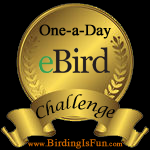
What is the difference between birdwatching and birding? At least for me, birdwatching involves, well, watching the birds. Enjoying and trying to figure out what each bird is doing. Birding, on the other hand, is more about roaming across the countryside to find and identify as many birds as possible--and especially to find rare and unusual birds not regularly seen in the area. Birders, in their quest to find more birds, often only watch birds long enough to identify them--which can be mere fragments of a second when it comes to the more common birds.
Moment of truth here: I'm a birder. I try to spend time actually watching and enjoying birds--but sometimes I get carried away in my quest to find more birds and have to consciously remind myself to spend more time watching each bird I find. On my way in to work this morning, I saw 12
Ring-billed Gulls at my local birding spot. It took me about 5 seconds to look at each bird to make sure that's what they really were. In maybe another two seconds I noticed how they were each perceptibly unique, with slightly different patterns of brown markings on their mostly white heads. But then, I moved on to scan the lake to see if there were other, more unusual, birds to be found.
As part of my therapy, to help me slow down and appreciate birds a bit more, I got a copy of
Advanced Bird Language, a series of lectures on eight CDs by tracker and environmental educator
Jon Young. In over nine hours of material, Young shows his listeners how to understand the ways that birds communicate to each other through their body movements and calls. Its hard to briefly describe what this is all about, but you can get a
quick introduction to this conception of bird language
here.
These teachings come out of the tracking tradition of
Tom Brown Jr., who has spent a lifetime teaching people how to track and enjoy watching animals--so a lot of the emphasis here is on how to tune into the alarm calls of birds that might lead you to find and follow the movements of weasels, foxes, deer, and other animals. But there is a lot here on these CDs that are useful even if that isn't your primary goal.
More than anything, these CDs are a mind-opening and expanding tool, helping us consider the world from the perspective of the bird, and showing us how we can tune into that world. That can be useful if you are a birdwatcher, and want to better understand the birds, or even a birder, and just want to find more birds. By learning to watch how birds respond to other birds, animals, and humans in their environment, it can help you be a better birder. A couple examples from my recent birding as I've been thinking about these concepts:
1) One day I'm birding at a local lake. There are a couple dozen
Ring-billed Gulls on the lake. I'm walking around looking for sparrows, not paying them much attention, when all of a sudden they all take off at once. OK, I think, something has alarmed them. Was it me? Since I'd been walking back and forth in the same general area for half an hour, I kind of doubted it. So I thought, what might alarm a flock of gulls? Well, birders who have spent much time out there already know the answer. Unless a dog is running through the flock, most loafing gulls aren't alarmed by anything less than an eagle. So I start scanning the skyline. There's a vulture flying in, but that doesn't seem quite right, so I keep watching it until it turns just right and I can see that it isn't a vulture, it is indeed a Bald Eagle. By being alert to the gulls and their alarm, I was able to see a bird that I might have not have otherwise paid attention to.
2) At another local spot, I was looking for sparrows by walking along the edge of a field. By moving slowly, I could see lots of sparrows fly up out of the grass into the bushes along the edge of the field. But how many was I missing? By looking out farther, I could see the birds flushing and flying off in a rolling wave about 40 yards ahead of me as I walked. It was amazing to watch this. By slowing down, I could get closer to the birds. But if I just walked normally I would flush a lot of birds before I was close enough to really see them well. Again, by paying attention to these sparrows flushing in response to my walk, I was able to adjust my walk to get closer to them, and I also learned where to look to see more birds. I can only wonder how many birds birders miss by not paying attention to the ring of birds flushing around them as they move through the woods or field.
3) Just the other day I was at the local nature center on the paths. I was moving slowly, paying attention to the birds flushing off the ground. I got great looks at some
Rusty Blackbirds that flushed up and by not moving too quickly I got to stare into their piercing yellow eyes. Very cool. Then I could see and here American Robins flushing all around me. They were calling and flying off all around me. Having listened to these CDs, I had a guess as to what was about to happen, so I just froze and watched. Sure enough, here came another person shuffling along one of the paths. Not being loud. Not being especially offensive or moving especially fast. But still flushing all the birds a minute or two before passing by. How many birds and other animals was this person not seeing? We were having two completely different experiences in the same woods.
So, this Advanced Bird Language stuff has given me lots to think about and continues to enhance my birding and birdwatching experiences. And, if you believe some of the comments on these CDs (and I do) my spiritual and emotional life is enhanced as well as my brain rewires itself to pay attention to more of what is going on around me.
So, if you are a birdwatcher and want to better understand the behavior of birds, these CDs will give you a lot to think about. Even if you are a die-hard birder, these CDS will give you cause to pause and can help you adjust and enhance your birdfinding skills. And if you are just a nature lover or a poet or an eco-mystic, there is plenty here to help ground and enhance your enjoyment and appreciation of nature. And for librarians, I suggest that local libraries get a copy of Advanced Bird Language so that these messages can be more readily available to everyone in our communities.
 At noon today Audubon and the American Bird Conservancy held a joint press conference (audio here) to announce the release of the new WatchList of rare birds in the United States. The latest analysis draws upon the last 40 years of Christmas Bird Count and Breeding Bird Survey data to identify the 178 most imperiled birds. You can read the technical report here, or visit the new WatchList 2007 website here.
At noon today Audubon and the American Bird Conservancy held a joint press conference (audio here) to announce the release of the new WatchList of rare birds in the United States. The latest analysis draws upon the last 40 years of Christmas Bird Count and Breeding Bird Survey data to identify the 178 most imperiled birds. You can read the technical report here, or visit the new WatchList 2007 website here.











